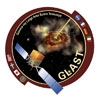Gamma-ray Large Area Space Telescope
INFN-BARIHome | Bari activities in GLAST | Conferences | Instrument | Science topics | Meetings in Bari | Gallery | GLAST related links |
People|
Bari activities in GLAST
The Bari group has worked on the GLAST project since 2000 and it has been involved in the construction and test of the silicon Tracker. |
|
|
NASA's GLAST mission is an astrophysics and particle physics partnership, developed in collaboration with the U.S. Department of Energy, along with important contributions from academic institutions and partners in France, Germany, Italy, Japan, Sweden, and the United States. |
|

